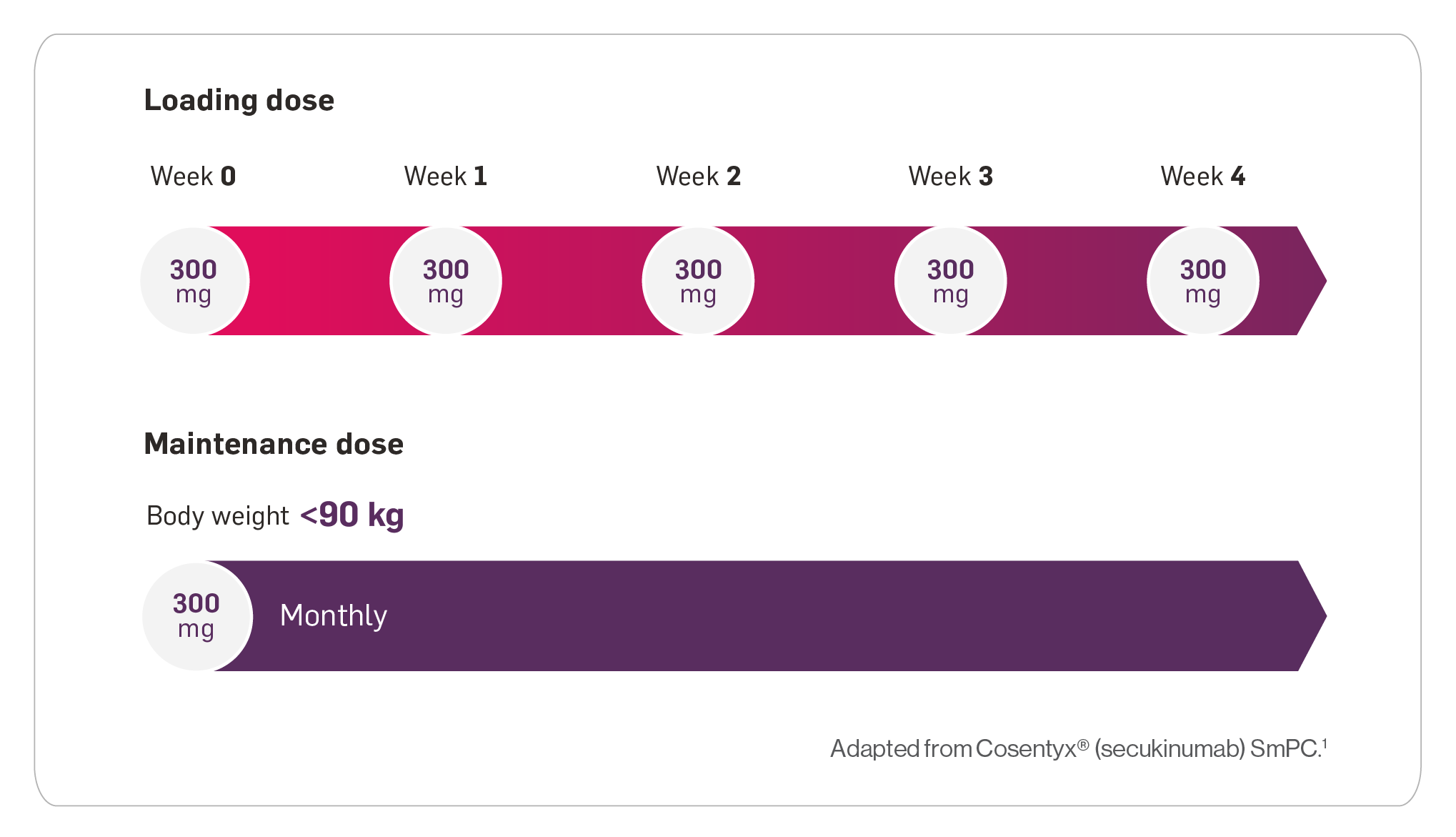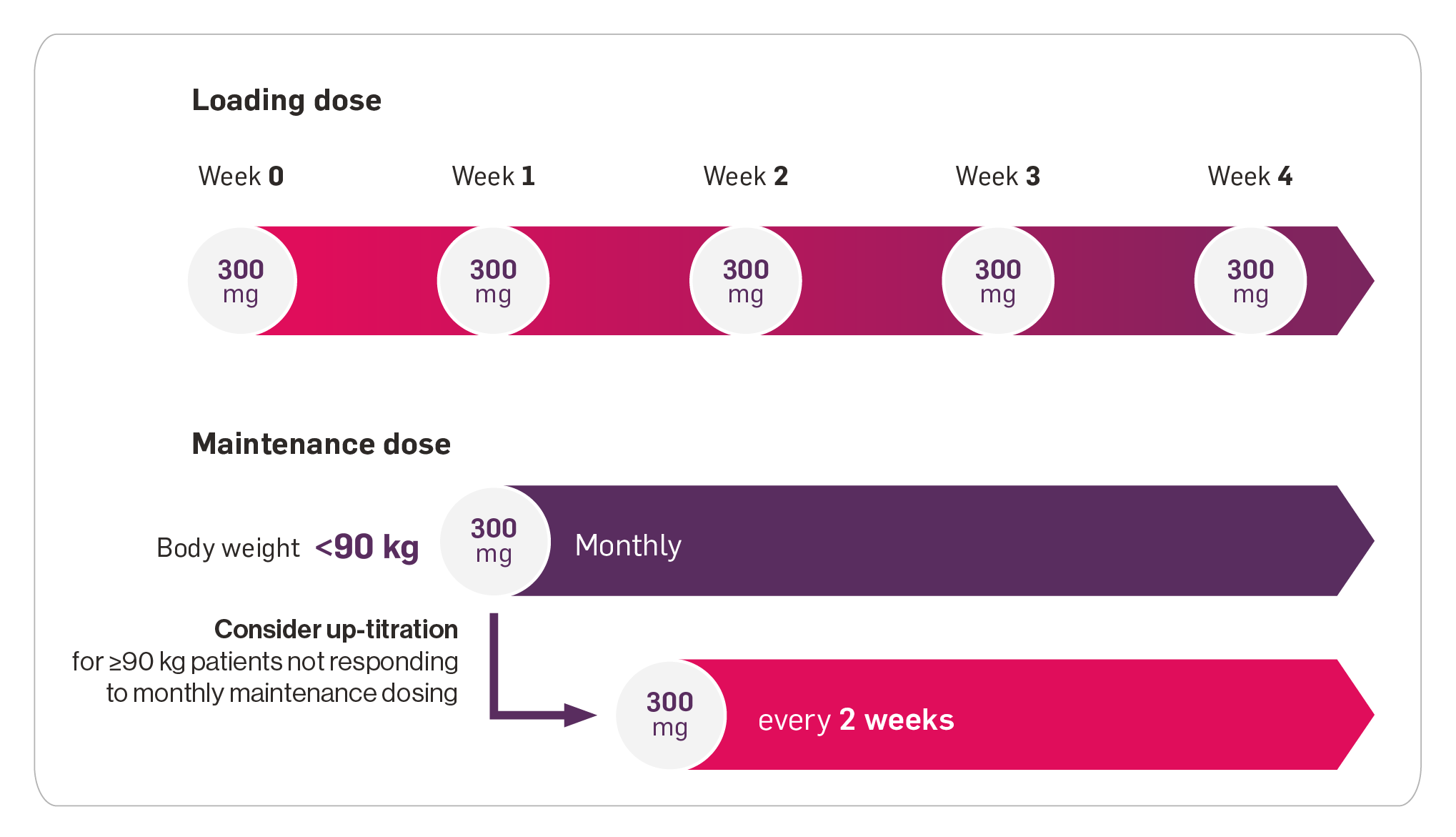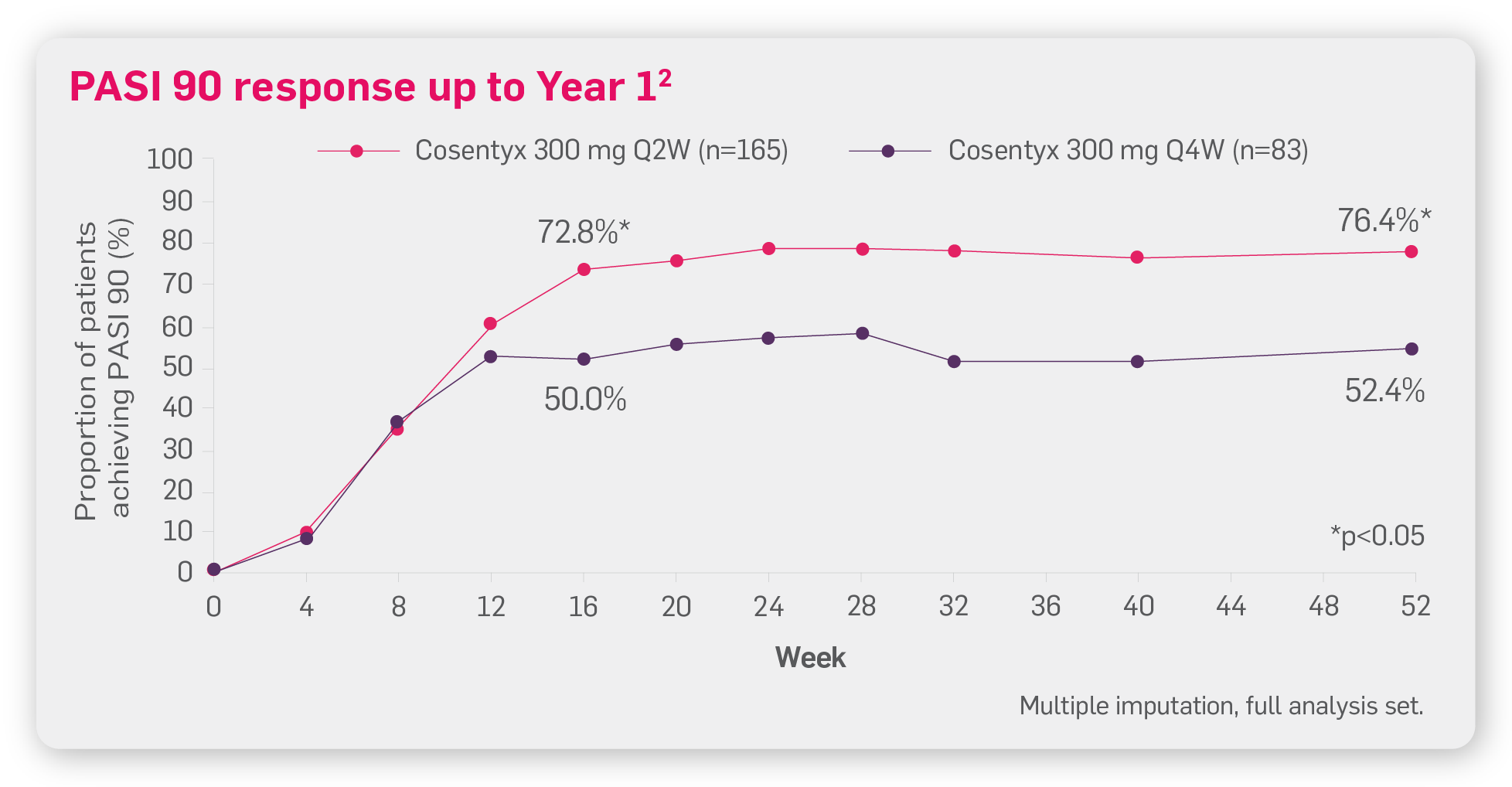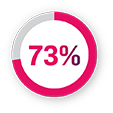

Cosentyx® (secukinumab): Real-world experience with flexible dosing in eligible patients
Cosentyx® (secukinumab) is indicated for the treatment of moderate to severe plaque psoriasis (PsO) in adults, children and adolescents from the age of 6 years who are candidates for systemic therapy; active psoriatic arthritis (PsA) in adult patients (alone or in combination with methotrexate [MTX]) when the response to previous disease-modifying anti-rheumatic drug therapy has been inadequate; active moderate to severe hidradenitis suppurativa (HS; acne inversa) in adults with an inadequate response to conventional systemic HS therapy.1
Cosentyx is intended for use under the guidance and supervision of a physician experienced in the diagnosis and treatment of conditions for which Cosentyx is indicated.1
Information on the Cosentyx safety profile may be found on the Safety profile page of this website and the Cosentyx Summary of Product Characteristics.1
How can flexible dosing benefit eligible patients with PsO in the clinic?*
Watch the presentation
Watch Dr Donal O’Kane share outcomes from the first real-world study on the efficacy of Cosentyx Q2W dosing in eligible patients with moderate-to-severe PsO and weighing ≥90 kg.
Understand the different dosing options with Cosentyx
Cosentyx offers flexible dosing in eligible adult patients with PsO1
The recommended dose of Cosentyx in adults with PsO is 300 mg delivered at Weeks 0, 1, 2, 3 and 4, followed by a monthly maintenance dose.1
Based on clinical response, patients with PsO weighing ≥90 kg may benefit from a maintenance dose of 300 mg every 2 weeks.1
For patients who weigh <90 kg, the recommended Cosentyx dose is 300 mg with initial dosing at Weeks 0, 1, 2, 3 and 4, followed by monthly maintenance dosing.1

For patients who weigh ≥90 kg, the recommended Cosentyx dose is 300 mg with initial dosing at Weeks 0, 1, 2, 3 and 4, followed by monthly maintenance dosing. Maintenance dosing may be up-titrated for patients weighing ≥90 kg to 300 mg every 2 weeks depending on clinical response.1

Help eligible patients achieve fast and lasting skin clearance with Cosentyx 300 mg Q2W2
Fast = efficacy at 16 weeks and lasting = efficacy at 52 weeks.2
You can tailor the dosing of Cosentyx based on your PsO patients’ clinical response. In the A2324 clinical trial, FAST and LONG-LASTING skin clearance was seen in patients (≥90 kg) treated with Cosentyx 300 mg Q2W.2

Adapted from Augustin M, et al. 2022.2
A2324 was a multicentre, double-blind, parallel-group trial on patients with moderate to severe PsO weighing ≥90 kg (N=331) treated with Cosentyx 300 mg Q2W or Q4W.†2
Primary endpoint of PASI 90 response at Week 16 for Cosentyx 300 mg Q2W vs Q4W was met, p=0.0003.2
Please note that the p-value of p=0.0003 is related to the primary endpoint. For the exploratory endpoint at Year 1, the p-value is <0.05.2
Safety findings were comparable across Cosentyx 300 mg Q2W and Q4W regimes in patients weighing ≥90 kg2
| Treatment-emergent AEs, n (%) | Cosentyx | Cosentyx | Cosentyx 300 mg Q4W |
|---|---|---|---|
All AEs | 127 (77.0) | 97 (72.4) | 24 (77.4) |
AEs possibly related to Cosentyx | 34 (20.6) | 29 (21.6) | 5 (16.1) |
All non-fatal SAEs | 14 (8.5) | 17 (12.7) | 4 (12.9) |
Deaths§ | 0 (0.0) | 1 (0.7) | 0 (0.0) |
Discontinued study treatment due to AEs | 4 (2.4) | 9 (6.7) | 2 (6.5) |
Treatment-emergent SAEs by SOC term‖ | |||
Infections and infestations | 1 (0.6) | 6 (4.5) | 2 (6.5) |
Injury, poisoning and procedural complications | 3 (1.8) | 3 (2.2) | 1 (3.2) |
Gastrointestinal disorders | 0 (0.0) | 4 (3.0) | 1 (3.2) |
Cardiac disorders | 1 (0.6) | 3 (2.2) | 1 (3.2) |
Respiratory, thoracic and mediastinal disorders | 3 (1.8) | 1 (0.7) | 0 (0.0) |
Musculoskeletal and connective tissue disorders | 3 (1.8) | 0 (0.0) | 0 (0.0) |
General disorders and administration site conditions | 2 (1.2) | 1 (0.7) | 0 (0.0) |
Most frequent AEs by preferred term¶ | |||
Nasopharyngitis | 32 (19.4) | 22 (16.4) | 5 (16.1) |
Upper respiratory tract infection | 12 (7.3) | 9 (6.7) | 3 (9.7) |
Headache | 11 (6.7) | 6 (4.5) | 1 (3.2) |
Diarrhoea | 10 (6.1) | 6 (4.5) | 2 (6.5) |
Arthralgia | 7 (4.2) | 6 (4.5) | 2 (6.5) |
Oropharyngeal pain | 3 (1.8) | 7 (5.2) | 2 (6.5) |
Cough | 7 (4.2) | 2 (1.5) | 2 (6.5) |
Back pain | 3 (1.8) | 6 (4.5) | 2 (6.5) |
AEs of special interest | |||
Infections and infestations (SOC) | 76 (46.1) | 63 (47.0) | 18 (58.1) |
Hypersensitivity (SMQ narrow) | 14 (8.5) | 6 (4.5) | 0 (0.0) |
Candida infections (HLT) | 3 (1.8) | 6 (4.5) | 1 (3.2) |
Neutropenia (NMQ narrow) | 7 (4.2) | 5 (3.7) | 3 (9.7) |
IBD (NMQ narrow) | 0 (0.0) | 0 (0.0) | 0 (0.0) |
MACE (NMQ) | 0 (0.0) | 2 (1.5) | 0 (0.0) |
Adapted from Augustin M, et al. 2022.2
The most frequently reported adverse reactions are upper respiratory tract infections (17.1%) most frequently nasopharyngitis, rhinitis.1
Cosentyx has the potential to increase the risk of infections. Caution should be exercised when considering the use of Cosentyx in patients with a chronic infection or a history of recurrent infection.1 Cosentyx is contraindicated in patients with clinically important, active infections, e.g., active tuberculosis.1
Cosentyx is not recommended in patients with inflammatory bowel disease. If a patient develops signs and symptoms of inflammatory bowel disease or experiences an exacerbation of pre-existing inflammatory bowel disease, Cosentyx should be discontinued and appropriate medical management should be initiated.1
Please refer to the SmPC for detailed safety data and full prescribing and administration information, including dosing in special populations and warnings/precautions.1
Cosentyx is intended for use under the guidance and supervision of a physician experienced in the diagnosis and treatment of conditions for which Cosentyx is indicated. Please refer to the Cosentyx SmPC for full product information before prescribing.1
Therapeutic Indications1
Cosentyx is indicated for the treatment of moderate to severe plaque psoriasis (PsO) in adults, children and adolescents from the age of 6 years who are candidates for systemic therapy; active psoriatic arthritis (PsA) in adult patients (alone or in combination with methotrexate [MTX]) when the response to previous disease-modifying anti-rheumatic drug therapy has been inadequate; active ankylosing spondylitis (AS) in adults who have responded inadequately to conventional therapy; active nonradiographic axial spondyloarthritis (nr-axSpA) with objective signs of inflammation as indicated by elevated C-reactive protein and/or magnetic resonance imaging evidence in adults who have responded inadequately to non-steroidal anti-inflammatory drugs; active moderate to severe hidradenitis suppurativa (HS; acne inversa) in adults with an inadequate response to conventional systemic HS therapy; active enthesitis-related arthritis (ERA) in patients 6 years and older (alone or in combination with MTX) whose disease has responded inadequately to, or who cannot tolerate, conventional therapy; active juvenile psoriatic arthritis (JPsA) in patients 6 years and older (alone or in combination with MTX) whose disease has responded inadequately to, or who cannot tolerate, conventional therapy.1
*Eligible patients are those weighing ≥90 kg.1
†A2324: A multicentre, double-blind, parallel group trial of patients weighing ≥90 kg (N=331) in patients with moderate to severe PsO. Patients received either Cosentyx 300 mg Q2W or Q4W. At Week 16, patients from the Q4W arm who did not achieve a PASI 90 response (nonresponders) either remained on Cosentyx 300 mg Q4W or switched to the Cosentyx 300 mg Q2W regimen until the end of treatment. The primary endpoint was PASI 90 response at Week 16. At Week 16, Q2W led to significantly higher PASI 90 responses vs Q4W (n=165; 73.2% vs 55.5%; p=0.0003). Secondary endpoints were the proportion of patients achieving an IGA mod 2011 score of 0 or 1 (indicating clear or almost clear skin) at Week 16, and clinical safety and tolerability measures (clinical laboratory parameters, vital signs, electrocardiograms and adverse events) up to Week 52.2
‡One patient who did not receive any study treatment after randomisation was excluded from the Q4W safety analyses.2
§One death was reported in the Q4W group (patient was aged 83 years with ongoing medical conditions of hyperlipidemia, hypertension and aortic stenosis, and died during treatment period 2 of cardiac arrest/acute MI).2
‖Number of patients ≥3 in the overall study population.2
¶Number of patients ≥10 in the overall study population.2
AE, adverse event; AS, ankylosing spondylitis; ERA, enthesitis-related arthritis; GMC, General Medical Council; HLT, high-level term; HS, hidradenitis suppurativa; IBD, inflammatory bowel disease; JPsA, juvenile psoriatic arthritis; MACE, major adverse cardiovascular event; MI, myocardial infarction; MTX, methotrexate; NMQ, Novartis MedDRA Query; nr-axSpA, non-radiographic axial spondyloarthritis; PASI, psoriasis area and severity index; PsA, psoriatic arthritis; PsO, plaque psoriasis; Q2W, every 2 weeks; Q4W, every 4 weeks; SAE, serious adverse event; SmPC, summary of product characteristics; SMQ, Standardised MedDRA Query; SOC, system organ class.
References
Cosentyx® (secukinumab) Summary of Product Characteristics.
Augustin M, et al. Br J Dermatol 2022;186(6):942–954.
UK | April 2025 | FA-11332697
Adverse events should be reported. Reporting forms and information can be found at www.mhra.gov.uk/yellowcard. Adverse events should also be reported to Novartis online through the pharmacovigilance intake (PVI) tool at www.novartis.com/report, or alternatively email [email protected] or call 01276 698370.



